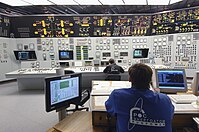
Back Turvakriittinen järjestelmä Finnish Système critique French מערכת חיים חיונית HE Sistema critico Italian 生命攸關系統 Chinese
This article needs additional citations for verification. (April 2009) |
A safety-critical system[2] or life-critical system is a system whose failure or malfunction may result in one (or more) of the following outcomes:[3][4]
- death or serious injury to people
- loss or severe damage to equipment/property
- environmental harm
A safety-related system (or sometimes safety-involved system) comprises everything (hardware, software, and human aspects) needed to perform one or more safety functions, in which failure would cause a significant increase in the safety risk for the people or environment involved.[5] Safety-related systems are those that do not have full responsibility for controlling hazards such as loss of life, severe injury or severe environmental damage. The malfunction of a safety-involved system would only be that hazardous in conjunction with the failure of other systems or human error. Some safety organizations provide guidance on safety-related systems, for example the Health and Safety Executive in the United Kingdom.[6]
Risks of this sort are usually managed with the methods and tools of safety engineering. A safety-critical system is designed to lose less than one life per billion (109) hours of operation.[7][8] Typical design methods include probabilistic risk assessment, a method that combines failure mode and effects analysis (FMEA) with fault tree analysis. Safety-critical systems are increasingly computer-based.
Safety-critical systems are a concept often used together with the Swiss cheese model to represent (usually in a bow-tie diagram) how a threat can escalate to a major accident through the failure of multiple critical barriers. This use has become common especially in the domain of process safety, in particular when applied to oil and gas drilling and production both for illustrative purposes and to support other processes, such as asset integrity management and incident investigation.[9]
- ^ J.C. Knight (2002). "Safety critical systems: challenges and directions". IEEE. pp. 547–550.
- ^ "Safety-critical system". encyclopedia.com. Retrieved 15 April 2017.
- ^ Sommerville, Ian (2015). Software Engineering (PDF). Pearson India. ISBN 978-9332582699. Archived from the original (PDF) on 2018-04-17. Retrieved 2018-04-18.
- ^ Sommerville, Ian (2014-07-24). "Critical systems". an Sommerville's book website. Archived from the original on 2019-09-16. Retrieved 18 April 2018.
- ^ "FAQ – Edition 2.0: E) Key concepts". IEC 61508 – Functional Safety. International Electrotechnical Commission. Archived from the original on 25 October 2020. Retrieved 23 October 2016.
- ^ "Part 1: Key guidance" (PDF). Managing competence for safety-related systems. UK: Health and Safety Executive. 2007. Retrieved 23 October 2016.
- ^ FAA AC 25.1309-1A – System Design and Analysis
- ^ Bowen, Jonathan P. (April 2000). "The Ethics of Safety-Critical Systems". Communications of the ACM. 43 (4): 91–97. doi:10.1145/332051.332078. S2CID 15979368.
- ^ CCPS in association with Energy Institute (2018). Bow Ties in Risk Management: A Concept Book for Process Safety. New York, N.Y. and Hoboken, N.J.: AIChE and John Wiley & Sons. ISBN 9781119490395.



